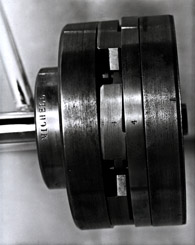
Michell thrust bearing
1907
low-friction bearing for thrust shafts
If the engine shaft that turns a ship's propeller isn't attached to the hull of the ship, the propeller will tend to push the shaft forward through the engine and leave the ship behind.
But how can you secure a spinning shaft? In the early days, up to 14 large metal collars containing 'thrust bearings' were placed along the propeller shaft to attach it to the hull. Unfortunately these overheated because of friction between the shaft, the bearing and the collar.
In 1905 the Australian engineer George Michell (pronounced Mitchell) who had improved the theory of lubrication, patented a new thrust bearing.
Michell's bearing created wedges of oil inside the spinning bearing to reduce friction between it and the shaft it held in place.
These super efficient new bearings were one-tenth the size of old ones and opened the way for larger propellers and engines in ships.
The bearing's advantages of small size, low friction and long life were particularly important for the new turbine powered ships, and the war saw a huge increase in the number of ships using Michell bearings. Since then, they have become the standard bearing used on turbine shafts in ships and power plants everywhere.
Who Did It?
Key Organisations
Michell Bearings Limited : design, manufacture
George Weymouth Pty Ltd (Australia) : initial manufacture
Key People
George Michell : inventor, designer
Henry Newbigin : English partner
Further Reading
'Michell, Anthony George Maldon'
Sydney Walker
Australian dictionary of biography(1891-1939), pp 492-494.
Links
ATSE
Technology in Australia 1788-1988
G M Michell
Time
magazine. Innovators
Questions & Activities
Michell thrust bearing
|










